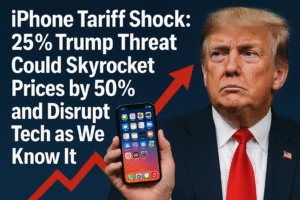iPhone Tariff Shock: 25% Trump Threat Could Skyrocket Prices by 50% and Disrupt Tech as We Know It
Former President Donald Trump has threatened a 25% tariff on iPhones made overseas and sold in the U.S. by 2025, pressuring Apple and rivals like Samsung to shift manufacturing stateside. While Trump frames this as a jobs-focused “America First” strategy, Apple faces a high-stakes dilemma: expanding production in India (a key growth market) risks U.S. tariffs, while relocating to America could spike production costs by 40–50% due to pricier labor, regulations, and supply chain disruptions. Analysts warn U.S.-built iPhones could exceed $3,000, alienating consumers and destabilizing Apple’s market dominance.
Critics argue tariffs might repeat past trade war pitfalls—raising consumer prices, inviting retaliatory measures, and straining global supply chains reliant on Asian manufacturing ecosystems. Supporters counter that reshoring could revive U.S. factories, though experts stress retraining workers and rebuilding infrastructure would take years. The move highlights a broader clash between economic nationalism and globalization, testing whether political mandates can realistically overhaul tech’s intricate, borderless production networks. Ultimately, Apple’s response—and consumer tolerance for cost hikes—will shape the future of manufacturing in an era of escalating trade tensions.

iPhone Tariff Shock: 25% Trump Threat Could Skyrocket Prices by 50% and Disrupt Tech as We Know It
In a bold move underscoring his “America First” agenda, former President Donald Trump has reignited debates over globalization and domestic manufacturing by threatening a 25% tariff on iPhones produced overseas and sold in the U.S. The policy, aimed at compelling Apple and other tech giants like Samsung and Huawei to shift production stateside, has sparked a clash between political priorities, economic realities, and consumer interests.
The Political Push: Jobs Over Globalization
Trump’s stance is clear: “American jobs come first.” During recent remarks, he emphasized that Apple’s plans to expand iPhone manufacturing in India—a move partly driven by India’s own high import tariffs—contradict his vision for revitalizing U.S. factories. While India has reportedly offered Apple tariff exemptions to attract investment, Trump insists the tech giant prioritize building plants in America. “Build here,” he urged CEO Tim Cook, signaling a broader strategy to pressure multinationals into reshoring operations.
The threat of tariffs, set to take effect by June 2025, isn’t limited to Apple. Trump explicitly warned that all smartphone makers selling in the U.S. market must comply or face levies, framing the policy as a matter of fairness.
Apple’s Dilemma: Costs, Markets, and Geopolitics
Apple’s interest in India isn’t just about avoiding local tariffs—it’s also a strategic play to tap into one of the world’s fastest-growing smartphone markets. However, Trump’s tariff proposal complicates this calculus. Relocating iPhone production to the U.S. would require overhauling a supply chain deeply rooted in Asia, where labor costs are lower and infrastructure is tailored to high-volume manufacturing.
Industry analysts estimate that iPhones assembled in the U.S. could see production costs surge by 40–50%, driven by higher wages, regulatory expenses, and the logistical challenges of recreating Asia’s supplier ecosystem. For consumers, this might translate to devices priced at $3,000 or more—a steep jump that could dampen demand and alter Apple’s market dominance.
The Ripple Effects: Beyond Apple
The proposed tariffs underscore a larger tension between protectionism and global trade dynamics. While supporters argue that reshoring could revive U.S. manufacturing jobs, critics warn of unintended consequences:
- Consumer Impact: Higher iPhone prices could disproportionately affect middle- and lower-income buyers, potentially slowing tech adoption.
- Supply Chain Chaos: Building a U.S.-based supply chain from scratch would take years and billions in investment, risking disruptions.
- Retaliatory Measures: Other nations might impose counter-tariffs on U.S. exports, escalating trade wars.
Economists also note that similar past efforts, like Trump’s 2019 tariffs on Chinese goods, had mixed results—boosting some sectors while raising costs for consumers and manufacturers reliant on imported materials.
The Human Factor: What’s Realistic?
While Trump’s vision appeals to workers in declining industrial regions, practical hurdles loom. Apple’s current U.S. manufacturing footprint is minimal (e.g., Mac Pro components in Texas), and scaling up iPhone production would require retraining workers, renegotiating supplier contracts, and navigating stricter environmental regulations.
Moreover, the 2025 timeline offers little breathing room. “It’s not just about building factories; it’s about reinventing an entire ecosystem,” says tech analyst Marina Zhu. “Apple’s agility will depend on whether policymakers offer incentives, like tax breaks or infrastructure support, to offset costs.”
The Bigger Picture: A Global Reckoning
Trump’s ultimatum reflects a growing skepticism of globalization, amplified by pandemic-era supply chain crises. Yet, the tech industry’s reliance on global networks isn’t easily undone. For Apple, balancing political pressure with market demands may mean diversifying production—expanding in India for local sales while cautiously investing in U.S. facilities for domestic distribution.
As the 2025 deadline approaches, the debate will hinge on whether the promise of jobs outweighs the pain of higher prices—and whether voters view tariffs as a necessary sacrifice or a costly misstep.
The tariff threat isn’t just about iPhones; it’s a litmus test for the future of manufacturing in an era of economic nationalism. Whether it sparks a U.S. industrial revival or stalls innovation in favor of political optics remains to be seen. One thing is certain: the world’s most valuable company—and its customers—are caught in the crossfire.
You must be logged in to post a comment.